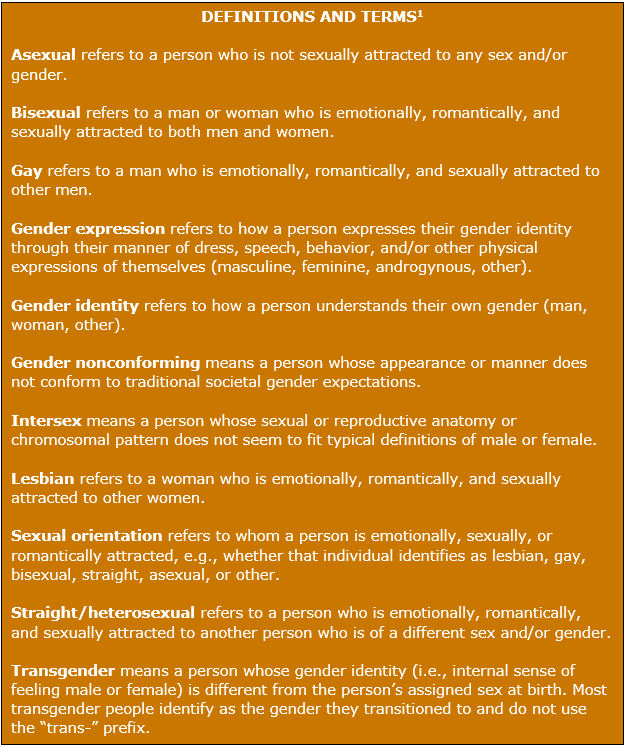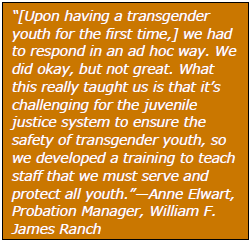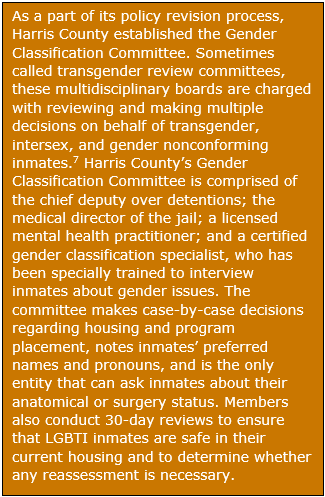
Research has shown that lesbian, gay, bisexual, and transgender (LGBT) people face a higher risk of sexual victimization in confinement. Recent Bureau of Justice Statistics surveys found that adults and youth in confinement who identify as lesbian, gay, or bisexual were much more likely to have experienced sexual victimization by another inmate than their heterosexual counterparts.2

Other studies have found that transgender inmates are more vulnerable to sexual victimization. For instance, a study of California state prisons found that transgender women housed in a men’s facility were 13 times more likely to have been sexually abused by another inmate than nontransgender inmates.6 Accordingly, the Prison Rape Elimination Act (PREA) standards include provisions directed at keeping LGBT and intersex (LGBTI) people safe and respected and give particular attention to the unique needs of transgender people in confinement.
Relevant Standards
The following PREA standards specifically address LGBTI inmates.
- Employee Training: §§115.31, 115.231, and 115.331—Employees must receive training in how to communicate effectively and professionally with all inmates, including LGBTI and gender nonconforming individuals.
- Screening Information: §§115.41, 115.241, and 115.341—Screening for risk of victimization and abusiveness must include whether an inmate is—or is perceived to be—LGBTI or gender nonconforming.
- Housing and Programming Placement: §§115.42, 115.242, and 115.342—LGBTI people cannot be held in dedicated facilities, units, or wings solely on the basis of their sexual orientation and/or gender identity.
- Sexual Abuse Incident Reviews: §§115.86, 115.186, 115.286, and 115.386—Incident reviews must consider whether the incident was motivated by gender identity or by LGBTI identification, status, or perceived status.
Several standards mandate that facilities respond to the distinct needs of transgender and intersex inmates and residents in the following areas.
- Housing and Programming Placement: §§115.42, 115.242, and 115.342—Decisions about housing and facility placement for transgender and intersex people must be made on a case-by-case basis. Inmates’ views of their own safety must be given serious consideration in this process. Placements need to be reassessed at least twice a year and include a review of any threats to safety experienced by these individuals. Additionally, transgender and intersex inmates must be given an opportunity to shower separately.
- Cross-Gender Viewing and Searches: §§115.15, 115.115, 115.215, and 115.315—No transgender or intersex inmate can be searched for the sole purpose of determining genital status. Instead, this information can be ascertained through conversations with the inmate or by reviewing medical records. If necessary, an exam can be conducted by a medical professional.
 Overview of Two Agencies
Overview of Two Agencies
In a recent webinar by the Vera Institute of Justice, leaders from the William F. James Ranch (James Ranch) and the Harris County Sheriff’s Office (Harris County) discussed their agencies’ efforts to implement comprehensive policies for LGBTI individuals in their custody. While these facilities serve very different populations, both agencies have taken significant steps to ensure that LGBTI individuals in their facilities are safe and respected. Harris County operates three adult jails in Houston, Texas. With approximately 9,000 beds, the agency is the third largest county jail system in the United States. In contrast, the James Ranch in suburban Santa Clara County, California, is a 96-bed co-ed facility for youth.

Catalysts for Change
While PREA includes provisions for keeping LGBTI residents and inmates safe from sexual abuse and sexual harassment, James Ranch and Harris County have instituted innovative policies that go beyond PREA requirements. Interestingly, both agencies were prompted to review their policies after having a transgender person in their care. Realizing that existing procedures had failed to serve and protect the transgender individuals in their facilities, James Ranch and Harris County each launched a complete review and retooling of existing policies.
Officials from Harris County and James Ranch stress that it is best to have comprehensive policies in place before a transgender, intersex, or gender nonconforming individual enters an agency’s custody. In addition to meeting the PREA Standards about treatment of LGBTI inmates and residents, both agencies have instituted additional policies to meet the unique needs of transgender people.
Policy Considerations
Incarcerated people who are transgender, intersex, or gender nonconforming require special consideration. Harris County and James Ranch revised their policies to establish protocols in the following areas.
- Housing Placement—Both agencies take an individualized approach when making housing decisions for transgender and intersex individuals. James Ranch’s LGBTI policy states, “Transgender youth shall not automatically be housed according to their birth sex.” This means that a transgender girl who was born biologically male could be placed in a female unit if that is where staff and the individual feel she would be safest. James Ranch also makes individualized housing decisions for intersex youth. Harris County delegates housing decisions and programming placement for transgender and intersex individuals to their Gender Classification Committee.
- Searches—Staff at James Ranch and Harris County ask transgender individuals about their preference of staff gender for pat-downs and strip searches.
- Pronouns and Names—Both agencies’ LGBTI policies require that staff address inmates or residents by their preferred name and pronoun. James Ranch solicits this information from youth via their Transgender Preference Form. In Harris County jails, this notation is made by the Gender Classification Committee.
- Clothing and Commissary Items—The policies include procedures for clothing, commissary purchases, and other items that may indicate gender identity and expression. Harris County has opened its full commissary list to inmates of all genders in all facilities. For instance, a transgender man may now order male undergarments if he chooses. James Ranch has also included protocol about clothing choice and gender expression in its policy. It reads, “Youth shall be allowed to dress and present themselves in a manner consistent with their gender identity. Youth will be permitted to groom according to their preferred gender expression regardless of housing assignment.”
Sustaining Culture Change: Shared Lessons
Acknowledging and understanding the dynamics of sexual orientation, gender identity, and gender expression is a crucial component of implementing LGBTI policies. This can be an unfamiliar and uncomfortable realm for correctional agencies and may require a shift in agency and staff culture. In the process of crafting new LGBTI policies, Harris County and James Ranch learned several key lessons about achieving sustainable culture change, which are described below.
- Engage Leadership—Leadership buy-in is an essential component of prompting culture change and sets the tone for policy development. Managers can help defuse staff resistance to policy changes by delivering consistent, credible messages that all staff play a crucial role in protecting LGBTI inmates. James Ranch learned that having someone of authority present at LGBTI trainings can help demonstrate the importance of these issues to staff and reinforce the expectation that everyone complies with new policies. In Harris County, County Sheriff Adrian Garcia issued the directive to create an LGBTI policy.
- Partner With Outside Experts—Outside consultants and community organizations can provide an invaluable perspective and help familiarize staff with the LGBTI community. For instance, at the beginning of their policy development, Harris County staff held a community meeting where they learned from Houston’s LGBTI citizens about the common issues affecting their community. Additionally, the department worked with a consultant who specializes in educating organizations about the equal treatment of transgender people. James Ranch partnered with a community advocacy organization that works to increase fairness and respect for LGBT juveniles in the justice system.

- Develop Trainings on New Policies—Like the general population, corrections staff often have varied understanding of LGBTI issues. Accordingly, it is necessary to train staff on sexual orientation, gender identity, and gender expression. James Ranch and Harris County each developed trainings to reinforce their new LGBTI policies. Working with a consultant, Harris County developed a 12-hour online education course for staff. Staff working directly with inmates also receive a four-hour, in-person course. James Ranch also developed trainings to reinforce that keeping all youth safe and respected is every staff member’s responsibility.
- Maintain Connections to the Community—Maintaining relationships with community organizations helps sustain culture change. For instance, Harris County works with a 30-person LGBTI Advisory Committee, comprised of outside community members, which continues to provide guidance to the jails. Additionally, the agency has an appointed LGBTI liaison who accepts any complaints about the treatment of LGBTI inmates from the public and external agencies. Harris County has conducted other forms of outreach to the Houston area, including having a float in the city’s gay pride parade. The agency is in the planning stages of the Safe Zone Project, which will provide select officers with a pin to wear in civilian settings to convey that they are trustworthy professionals for LGBTI individuals to approach with questions or concerns. Recognizing that youth come into contact with many different agencies as they move through the justice system, James Ranch has extended its training on LGBTI juveniles to many of Santa Clara County’s other agencies. To date, they have trained more than 800 officials, including judges, law enforcement, public defenders, mental health staff, and others.
2 Beck, Berzofsky, & Krebs, 2013; Beck, Cantor, Hartge, & Smith, 2013.
3 Beck, Berzofsky, et al., 2013.
4 Ibid.
5 The Bureau of Justice Statistics surveyed 273 state-operated juvenile facilities and 53 locally or privately operated facilities holding adjudicated youth on behalf of the state. See Beck, Cantor, et al., 2013.
6 Jenness, Maxson, Matsuda, & Sumner, 2007.
7 Marksamer & Tobin, 2013.
Beck, A. J., Berzofsky, M., Caspar, R., & Krebs, C. (2013). Sexual victimization in prisons and jails reported by inmates, 2011–12. Washington, DC: Bureau of Justice Statistics. Retrieved from http://www.bjs.gov/content/pub/pdf/svpjri1112.pdf
Beck, A. J., Cantor, D., Hartge, J., & Smith, T. (2013). Sexual victimization in juvenile facilities reported by youth, 2012. Washington, DC: Bureau of Justice Statistics. Retrieved from http://www.bjs.gov/content/pub/pdf/svjfry12.pdf
Harris County Sheriff’s Office. (2013). Department manual: Lesbian, gay, transgender and intersex (LGBTI). Retrieved from http://www.harriscountyso.org/documents/PREA/HCSO_LGBTI_Policy.pdf
Jenness, V., Maxson, C. L., Matsuda, K. N., & Sumner, J. M. (2007). Violence in California correctional facilities: An empirical examination of sexual assault. Retrieved from http://www.wcl.american.edu/endsilence/documents/ViolenceinCaliforniaCorrectionalFacilities.pdf
National Institute of Corrections. (n.d.) Online library on lesbian, gay, bisexual, transgender, and intersex offenders. Retrieved from http://nicic.gov/lgbti
National Institute of Corrections. (2012, November). LGBTI populations: Their safety, your responsibility. Retrieved from http://nicic.gov/library/026763
National Institute of Corrections. (2014, May). LGBTI populations: Intake—Creating a culture of safety. Retrieved from http://nicic.gov/library/027998
National PREA Resource Center. (2014, September). Definitions and terms. Presented at the PREA auditor training, Columbia, South Carolina.
National PREA Resource Center. (2014, December). Understanding LGBTI Inmates and Residents. Webinar. Retrieved from http://www.prearesourcecenter.org/training-and-technical-assistance/webinars/2670/understanding-lgbti-inmates-and-residents
Marksamer, J., & Tobin, H. J. (2013). Standing with LGBT prisoners: An advocate’s guide to ending abuse and combating imprisonment. Retrieved from National Center on Transgender Equality website, http://transequality.org/PDFs/JailPrisons_Resource_FINAL.pdf
Santa Clara County Probation Department. Juvenile lesbian, gay, bisexual, and transgender policy. San Jose, CA: Author.
Santa Clara County Probation Department. Transgender preference form. San Jose, CA: Author.